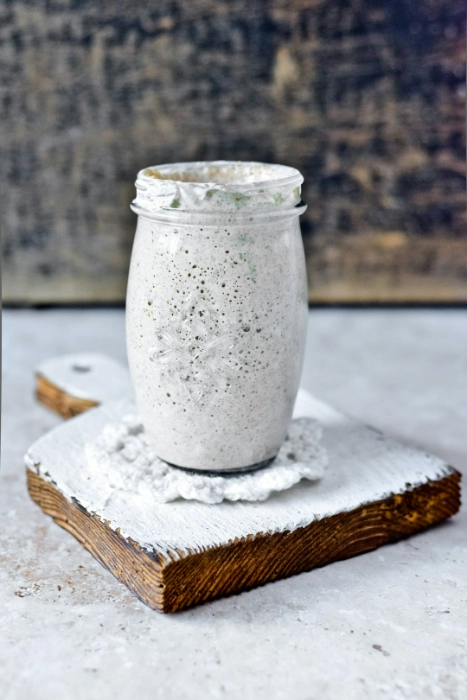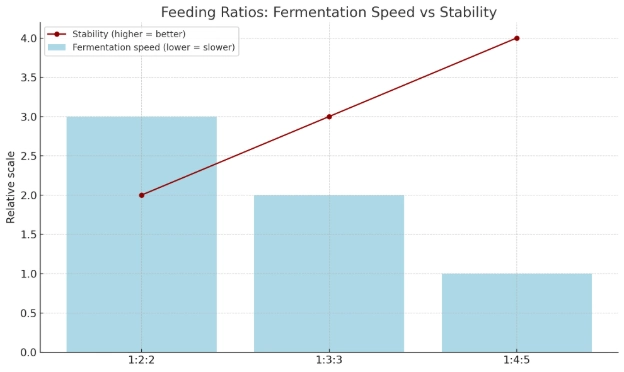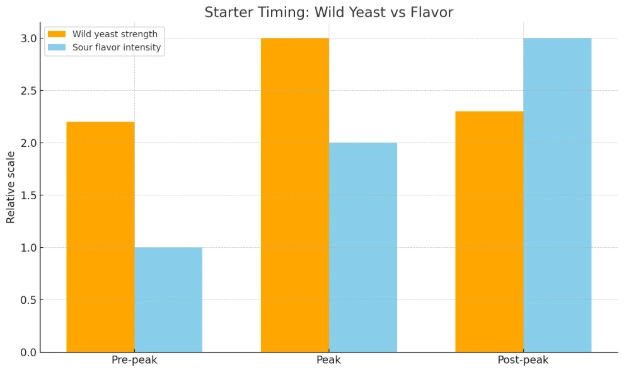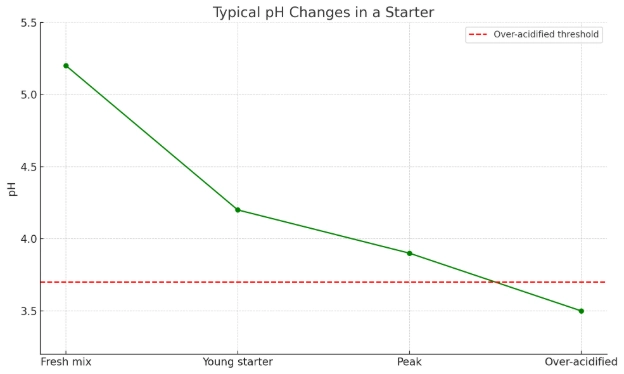Acidic Sourdough Starter: Causes, pH & Fixes

-
How a sourdough starter works (wild yeast and LAB)
-
Typical pH ranges and why they matter
-
What does pH influence? (Geek tool insight)
-
Feeding strategies: why ratios matter
-
Storage: fridge vs countertop
-
Timing your starter: pre-peak, peak, and post-peak
-
Clear signs your starter is too acidic
-
pH measurement: optional geek tool
-
Prevention & maintenance
-
FAQ — Acidic Sourdough Starter
- What pH should a sourdough starter be?
- How do I fix an over-acidified starter fast?
- Which feeding ratio should I use long-term?
- Does flour type change acidity?
- Should I store my starter in the fridge?
- When is the best time to use my starter — pre-peak, peak, or post-peak?
- Does chlorine in tap water hurt a starter?
- How long can I keep sourdough discard?
- Is it safe to scrape mold off and keep the starter?
- Do I need a pH meter to manage acidity?
-
Safety red flag reminder
-
Closing thoughts
-
Want to dive deeper? Check out these guides:
Once my starter smelled so sharply like vinegar, I hesitated to bake with it. The crumb ended up dense, and I realized: it wasn’t just a flavor issue - an over-acidified starter can lose its strength and structure.
One rule is non-negotiable: if you spot mold (green, pink, black, fuzzy), throw away the entire starter. Don’t scrape it off - spores penetrate deep, and using it can be unsafe. Start fresh or ask a friend for a healthy culture.
How a sourdough starter works (wild yeast and LAB)
A sourdough starter is a living ecosystem of wild yeasts and bacteria working together:
Wild yeasts (like Saccharomyces or Candida milleri) produce carbon dioxide and ethanol, helping dough rise.
LAB (lactic acid bacteria) are beneficial microbes naturally present in flour and the environment. They produce lactic and acetic acids, which lower pH, give sourdough its tang, and help protect against harmful microbes.
Together they create balance - until conditions push the starter too far toward acidity.
Typical pH ranges and why they matter
Freshly mixed starter: pH around 5.0–5.5
Young levain: pH 4.2–4.0
Mature starter: pH 3.9–3.7
Below 3.7: often a sign of over-acidification
Remember: pH is logarithmic - a drop of one unit means 10× more acidity. Small changes are significant.
What does pH influence? (Geek tool insight)
Factor | What it influences | Why it matters | Signs you’ll notice |
|---|---|---|---|
Enzymes (amylase, protease) | Carbohydrate & protein breakdown | Fuel for wild yeast and dough structure | Slow rise, weak fermentation |
Gluten/protein stability | Acid weakens proteins | Too much → collapsed structure | Sticky, slack dough |
Microbial balance | pH filters microbes | LAB dominate, pathogens suppressed | More stable starter |
Acid profile (lactic vs acetic) | Flavor spectrum | Determines sharp vs mellow sourness | Different taste balance |
Flour’s buffering effect: whole grains and rye contain minerals and fibers that slow down pH drops (more acid can build before pH falls). White flour has less buffering, so acidity shows up faster. Although you might want to keep the white flour. Sourdough works best with the flour that you feed with.
Feeding strategies: why ratios matter
Many guides suggest 1:2:2 as a baseline. In practice, 1:4:5 is more stable, especially in warmer weather. In summer, stretching to 1:4:5.5 gives the starter even more food and slows acid build-up.
Higher flour ratio = more food = slower acidification
Firmer feedings resist runaway fermentation in heat
Starter stays active longer without collapsing
Different feeding ratios affect how fast your sourdough starter ferments. A higher flour ratio like 1:4:5 slows acid build-up and gives more stability compared to 1:2:2.
Note: Feeding ratios aren’t absolute. They depend on your environment, flour type, and room temperature. Use guides like these to get started, but experiment - your starter will tell you what works best.
Storage: fridge vs countertop
Countertop: Best for a strong, balanced starter - especially if you bake often.
Fridge: Convenient, but weakens bacterial populations over time.
If you refrigerate, feed the starter, leave it 1 hour at room temperature, then chill.
Before baking, refresh it at least twice at room temperature to regain strength. It still won’t be as vigorous as a countertop starter, but better than baking straight from the fridge.
Timing your starter: pre-peak, peak, and post-peak
When you use your starter changes flavor and performance:
Pre-peak: Mild flavor, weaker wild yeast activity → slower rise.
At peak: Strongest wild yeast activity, reliable rise, light sourness → ideal for most baking.
Post-peak: Tangier flavor, weaker wild yeast activity → sourer bread, slower fermentation.
At peak, wild yeast activity is strongest for reliable rise. Pre-peak gives a milder flavor but weaker fermentation, while post-peak leads to a tangier bread with slower rise.
Clear signs your starter is too acidic
Symptom | Likely cause | Fix |
|---|---|---|
Slow rise, little bubbling | LAB dominance, pH too low | Increase feeding ratio (e.g. 1:4:5), use cooler spot |
Dough sticky/weak | Acid-damaged gluten | Lower hydration, feed more often |
Sharp vinegar smell | Excess acetic acid | Refresh sooner, feed a higher ratio |
Mold/discoloration | Contamination | Discard completely, restart |
pH measurement: optional geek tool
pH strips or digital meters aren’t required, but they reveal acidity shifts:
Starter typically drops from ~5.0 → ~3.8 as it matures.
Peak activity often corresponds to pH around 4.0.
Below ~3.7: yeast activity weakens, fermentation slows.
A sourdough starter typically drops in pH as it matures. The healthy range is around 4.2–3.9; below 3.7 it may be over-acidified and wild yeast activity declines.
Think of pH as a geek’s window into your starter’s chemistry — fascinating, but optional.
Prevention & maintenance
Feed regularly, especially in warm conditions.
Use filtered or mineral water - chlorine in tap water can harm microbes.
Choose feeding ratios that suit your environment (try 1:2:2, 1:3:3, 1:4:5).
Don’t store the discard longer than a week.
Never compromise on mold: discard fully if you see it.
FAQ — Acidic Sourdough Starter
What pH should a sourdough starter be?
A healthy, mature starter typically has a pH level of around 3.9–4.2. If it drops to ~3.7 or lower, it’s often over-acidified: wild yeast weakens and fermentation slows.
How do I fix an over-acidified starter fast?
Reduce the amount of starter you carry over, feed at a higher flour ratio (like 1:4:5), keep it in a slightly cooler spot, and refresh more frequently for a short period. This slows acid build-up and restores balance.
Which feeding ratio should I use long-term?
While many guides suggest 1:2:2, long-term stability often comes from 1:4:5 (or even 1:4:5.5 in summer). The best ratio depends on your environment, flour, and temperature -experiment to find your ideal.
Does flour type change acidity?
Yes. Whole grain and rye flours have higher buffering capacity, slowing the pH drop, while white flour shows acidity faster. Mineral content and enzymes also affect flavor and acid production.
Should I store my starter in the fridge?
You can, but refrigeration weakens the culture over time. If you chill it, feed first, leave it 1 hour at room temperature, then refrigerate. Before baking, refresh it at least twice at room temperature for strength.
When is the best time to use my starter — pre-peak, peak, or post-peak?
Pre-peak: mild flavor, weaker wild yeast → slower rise.
Peak: strongest wild yeast activity, reliable rise, moderate tang → ideal for most breads.
Post-peak: tangier flavor, but weaker wild yeast → slower fermentation.
Does chlorine in tap water hurt a starter?
Yes. Chlorine can inhibit LAB and wild yeast. Use filtered or mineral water instead.
How long can I keep sourdough discard?
No more than about a week. After that, the flavor degrades and it won’t revive well in recipes. Collect fresh discard regularly.
Is it safe to scrape mold off and keep the starter?
No. Any mold (green, orange, pink, black, or fuzzy) indicates that the starter is unsafe. Spores penetrate deeply, so discard and restart.
Do I need a pH meter to manage acidity?
Not at all. It’s a geek tool that shows acidity trends (e.g., when nearing ~3.7 pH), but you can manage perfectly by watching the rise, smell, and timing.
Safety red flag reminder
Mold = no compromise. Colors like green, orange, pink, or fuzzy patches mean the whole starter is unsafe. Spores spread invisibly - don’t risk your health.
Closing thoughts
An acidic starter isn’t the end of the world - it’s a signal. By adjusting feed ratios and timing, you can bring it back into balance. With experience, you’ll learn to “read” your starter by looking, smelling, and rising, not just by the clock.
Want to dive deeper? Check out these guides:
How to Feed Your Sourdough Starter for Perfect Baking Results
How to Feed, Maintain, and Strengthen Your Sourdough Starter
How to Make Homemade Sourdough Bread: A Beginner’s Guide
-
How a sourdough starter works (wild yeast and LAB)
-
Typical pH ranges and why they matter
-
What does pH influence? (Geek tool insight)
-
Feeding strategies: why ratios matter
-
Storage: fridge vs countertop
-
Timing your starter: pre-peak, peak, and post-peak
-
Clear signs your starter is too acidic
-
pH measurement: optional geek tool
-
Prevention & maintenance
-
FAQ — Acidic Sourdough Starter
- What pH should a sourdough starter be?
- How do I fix an over-acidified starter fast?
- Which feeding ratio should I use long-term?
- Does flour type change acidity?
- Should I store my starter in the fridge?
- When is the best time to use my starter — pre-peak, peak, or post-peak?
- Does chlorine in tap water hurt a starter?
- How long can I keep sourdough discard?
- Is it safe to scrape mold off and keep the starter?
- Do I need a pH meter to manage acidity?
-
Safety red flag reminder
-
Closing thoughts
-
Want to dive deeper? Check out these guides:



